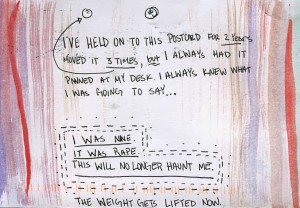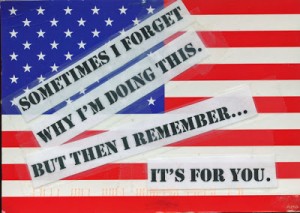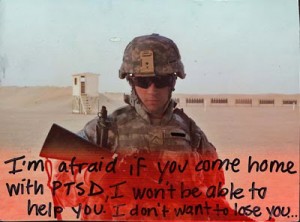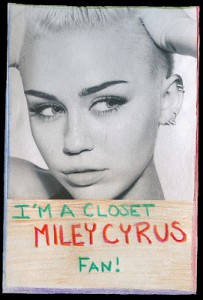In my last blog post I talked about Post Secret and how its aspect of anonymity helps people to release their secrets. I will now continue that discussion by focusing on how Post Secret can empower people who view the postcards to share their own secrets, and the way the project has the power to help the creators as well as the viewers ‘heal’ and “find their answers” as a form of therapy.
Secrets are inherently very powerful, and as Evan Imber – Black writes in his article, “The Power of Secrets“, they have very “destructive qualities”, able to break down relationships as well as ones own sanity. Keeping secrets bottled up inside can be dangerous to one’s mental heath and so the simplicity of writing the secret down and sending it away can help to someone move on and let go. This action of release for someone struggling with a secret could be therapeutic, as we can see in the postcard pictured below that reads, “I’VE HELD ON TO THIS POSTCARD FOR 2 YEARS MOVED IT 3 TIMES, BUT I ALWAYS HAD IT PINNED AT MY DESK. I ALWAYS KNEW WHAT I WAS GOING TO SAY… I WAS NINE IT WAS RAPE. THIS WILL NO LONGER HAUNT ME. THE WEIGHT GETS LIFTED NOW.” In this example one can tell that the trauma of being raped as a child has haunted him or her even into their adult life. Their struggle was evident, but once they released the secret they felt a sense of liberation.
The format of Post Secret benefits not only the person who sends in postcards but also those who read the blog, because it acts as a way for someone to relate to a struggle they are facing. When weighed down with a bottled up secret sometimes people can feel isolated and alone, like no one would understand their issue, or that people would be judge them for it, but Post Secret has become a place where someone struggling can find strength knowing other people face the same issues they do. On November 9, Frank Warren created a special post entitled “Soldiers Secrets”, where all of the submissions involved soldiers or their loved ones. Joining the army and going to serve in conflict is very emotionally and physically hard for soldiers and can be devastating on their loved ones, and so for either party going through issues about the military, reading posts of people going through similar troubles as you can be very beneficial. A postcard such as the one below that reads “SOMETIMES I FORGET WHY I’M DOING THIS. BUT THEN I REMEMBER… IT’S FOR YOU.” could help a solider regain strength to go into combat, while the second one which reads, “I’m afraid if you come home with PTSD, I won’t be able to help you. I don’t want to lose you.” could be relatable to people who have loved ones in combat and have similar fears.
Post Secret is a very unique and powerful blog, unlike any other another form of personal narration. It expresses sincere truth in a public domain, something that is now rare in our world plagued with ‘reality shows’. This project is intriguing and connects people through common problems, and can therefore help people through hardships. Post Secret is more than just a blog, it is a form of therapy.
*First picture accessed from http://www.postsecret.com on October 27, 2013. Second and third pictures accessed from http://www.postsecret.com on November 11, 2013






